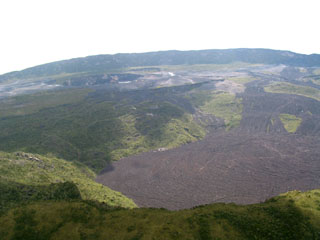Report on Nyamulagira (DR Congo) — 1 April-7 April 2009
Smithsonian Institution / US Geological Survey
Weekly Volcanic Activity Report, 1 April-7 April 2009
Managing Editor: Sally Sennert.
Please cite this report as:
Global Volcanism Program, 2009. Report on Nyamulagira (DR Congo) (Sennert, S, ed.). Weekly Volcanic Activity Report, 1 April-7 April 2009. Smithsonian Institution and US Geological Survey.
Nyamulagira
DR Congo
1.408°S, 29.2°E; summit elev. 3058 m
All times are local (unless otherwise noted)
A recent report from Goma Volcano Observatory (GVO) noted a seismic swarm from Nyamuragira during 23-27 January and increased seismicity along the East African Rift since then. Scientists who visited the Nyiragongo summit crater on 22 and 24 March saw intense fumarolic activity in the summit crater of Nyamuragira through binoculars. The activity was concentrated in the southern area. GVO noted that seismic swarms typically precede eruptions by 3-5 months and that an eruption could occur from the southern side.
Geological Summary. Africa's most active volcano, Nyamulagira (also known as Nyamuragira), is a massive high-potassium basaltic shield about 25 km N of Lake Kivu and 13 km NNW of the steep-sided Nyiragongo volcano. The summit is truncated by a small 2 x 2.3 km caldera that has walls up to about 100 m high. Documented eruptions have occurred within the summit caldera, as well as from the numerous flank fissures and cinder cones. A lava lake in the summit crater, active since at least 1921, drained in 1938, at the time of a major flank eruption. Recent lava flows extend down the flanks more than 30 km from the summit as far as Lake Kivu; extensive lava flows from this volcano have covered 1,500 km2 of the western branch of the East African Rift.

